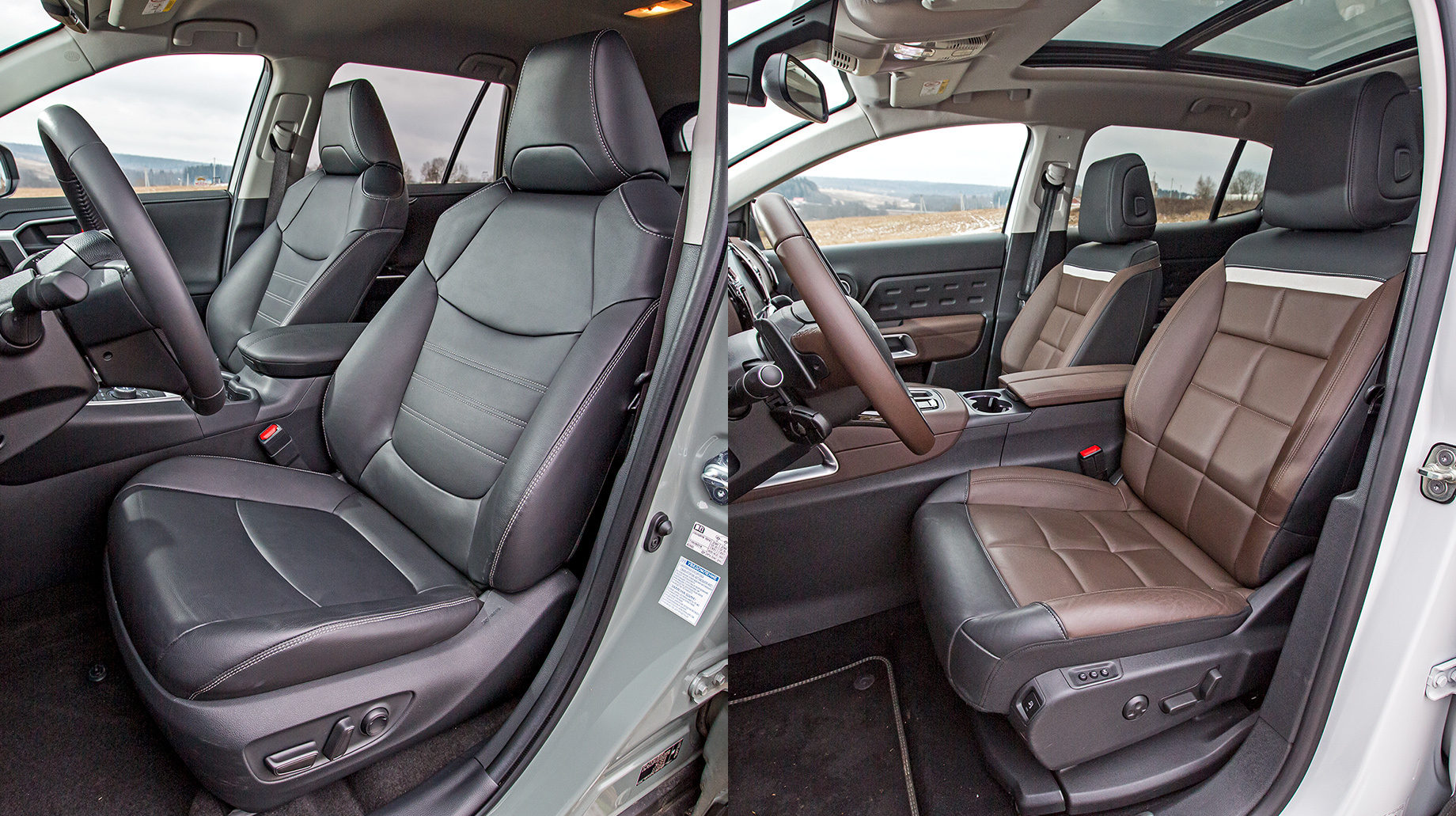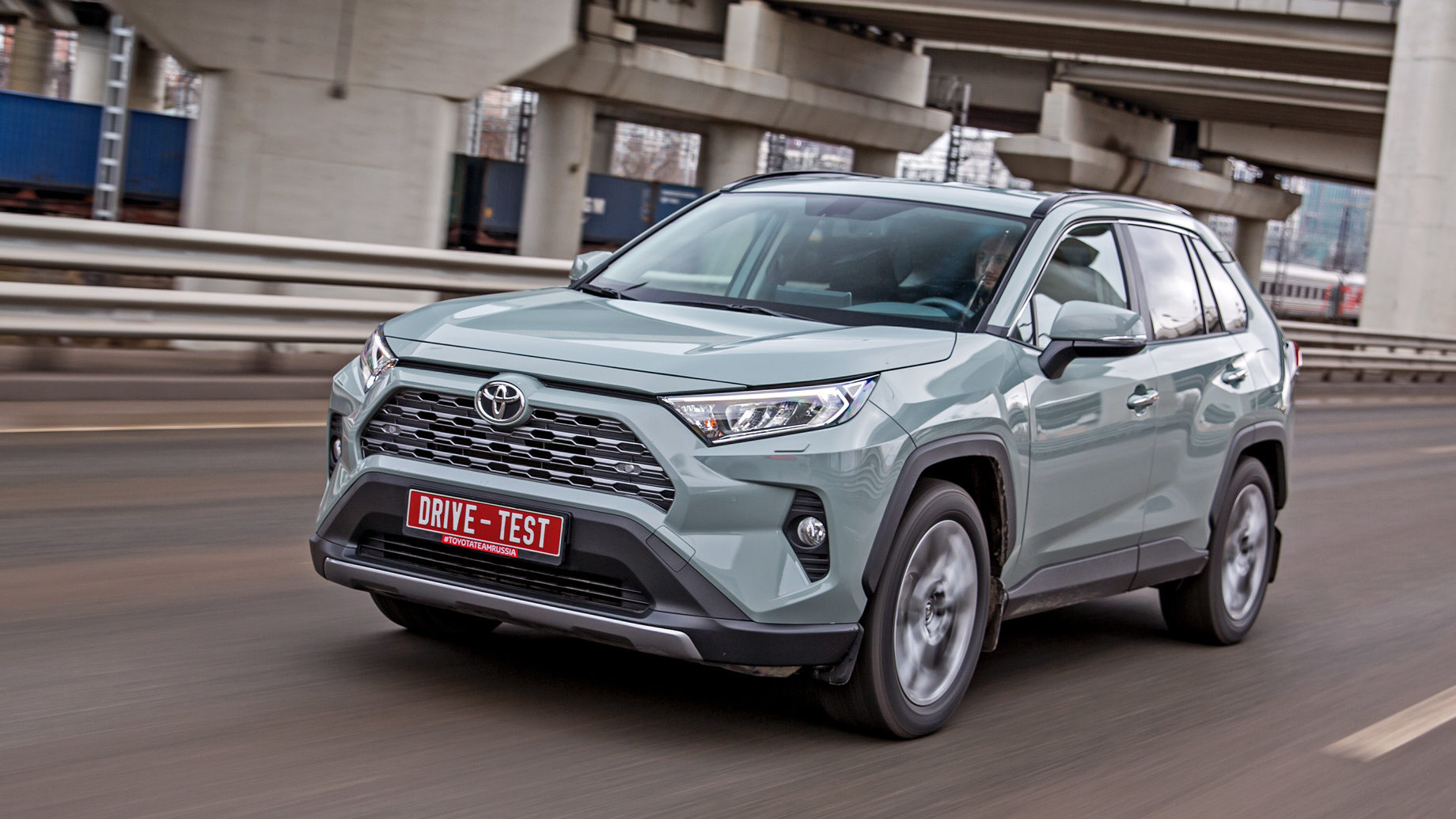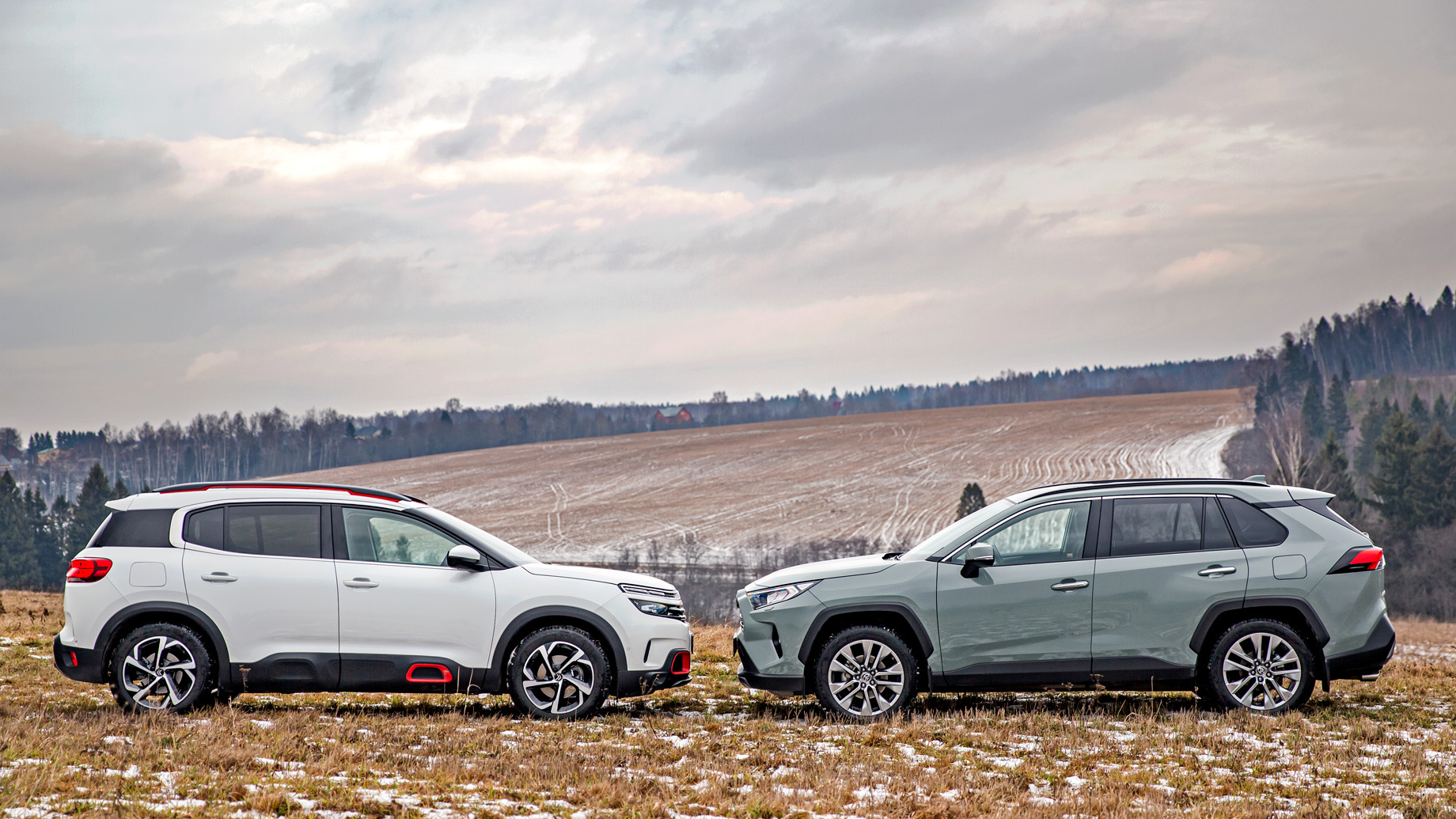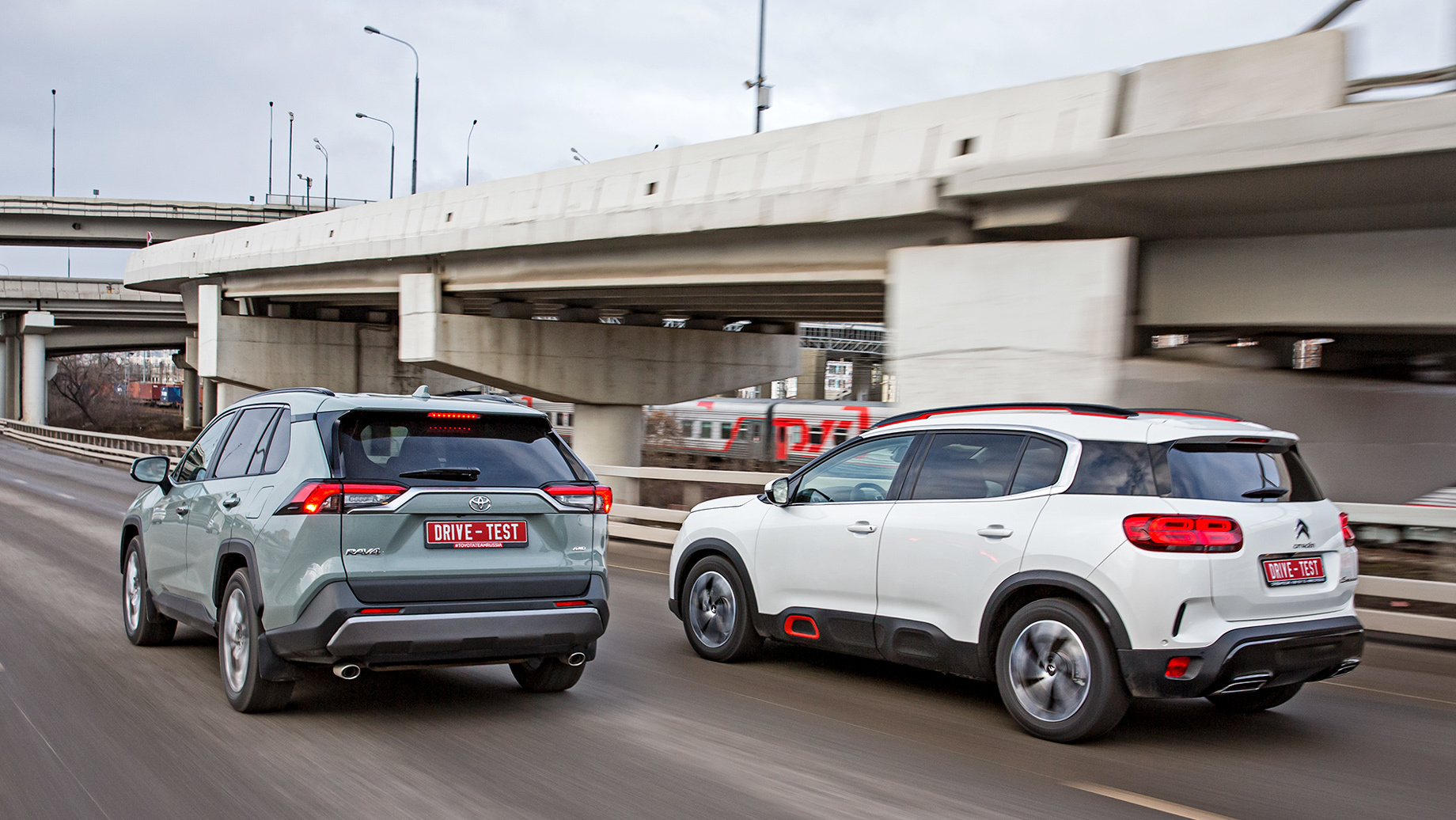I am sure that most of you opened this material with the question “how can they be compared?”. No matter how the commensurate C5 Aircross and RAV4 perform in the test, a certain buyer will choose Toyota dozens of times more often, or even hundreds. Nevertheless, the two hottest new products in the most popular segment are offered at a comparable price and have their own trump cards. But only the RAV4 can be all-wheel drive, even with the base 2.0 engine. But the C5 Aircross is available with a diesel. These are the options we chose for comparison. And found a surprising ideological similarity between them.
Both designs are interesting. Toyota rests on machismo, sometimes reminiscent of Prado or even Land Cruiser 200 — especially in the interior. Citroen is France itself, and that says it all. However, the ornate appearance in this case is spoiled by uneven body gaps. In the RAV4, although they are large, they are neat. All thresholds are covered with doors, and the keyless access works only on the front ones. The Japanese “largely” saved on the backlight: only the driver’s power window button glows blue on the door.

Surprisingly, although the proportion of soft upholstery materials in a Japanese car is objectively higher, its interior is perceived as cheaper. Small touches like fabric trim on the A-pillars or LED dome light help Citroen out. The avant-garde electronic instrument panel and automatic selector give the impression of a more modern, advanced car than the conservative RAV4. The containers for small items are larger and better finished.
Therefore, Toyota is hospitable in relation to rear passengers. There is more than enough space, even if you sit down in wading boots. Legs are easy to bring when getting into the car. The Citroen salon is just as wide, but you sit on the hard high seats as if on a perch. Moreover, protruding seat belt buckles prevent moving to the side. I would say that the C5 is well suited for transporting children: even the front seat has Isofix, and the rear mounts are moved apart so that a passenger can fit between two child seats. But the space is limited in length, the kids will get their feet up to the front backs.
Individual adjustment of the three parts of the rear sofa is also neither fish nor fowl: it can only be moved forward, increasing the trunk. The cargo compartments of the two cars are equal. The difference is that the Citroen is better finished. However, the tailgate rises only 5’8 from the ground. But, using a swing sensor, you can close the trunk and central locking at once without hands. In the case of Toyota, you will have to wait ten seconds for the electric drive to work, and then lock the car with a key fob or a button on the door.
The developers of the Toyota media system also went overboard with conservatism. It is depressing not only with dull graphics and modest functionality, but also with the need to reach for the screen and the buttons framing it. Driving position is high. Visibility is better than Citroen thanks to wider mirrors, moved away from the pillars, and developed cleaning zones for both the front and rear windows. The clear traditional CVT selector is shifted towards the passenger. Even in the right-hand drive version.

The first miles of the path RAV4 passes unexpectedly smoothly, swaying on smooth asphalt and gently, slightly delayed, reacting to all control actions. There are claims when accelerating up to comfortable speed. Even in the city, Toyota is noisy: the wheels are buzzing, the street is heard, the constant presence of the harmless, but intrusive sound of the engine is annoying. In the absence of еру pressure charging, there is not enough torque, and in response to any significant pressing of the accelerator, the motor is forced to climb 3000-4000 rpm.
Traction control is inconvenient. At low throttles — up to about a third of the floor pedal travel — the Toyota gearbox works as it should be for a variator: without a direct dependence of speed on speed variations. Release the accelerator, and they fall. Pressing again, I’m forced to wait until the transients pass. Sport mode doesn’t really help. Only with deep pedaling does the box imitate staggering, and the accuracy of speed control becomes acceptable. The limiting capabilities of the aspirated 2.0 are very good: overtaking by “pedal to the metal” is not scary.
Citroen reacts on pressing most buttons with a second hesitation. This is especially annoying when starting the engine. At idle, the diesel surprises with a vibration unnoticed during the first test drive. The Drive2 website shows that the case is not isolated: shivering appears either in the cold, or after several hundreds miles. However, the French motor can be forgiven a lot for assertive, quiet and gentle acceleration. Only the Aisin eight-speed automatic transmission in a traffic jam pulls worse than the DSG, chaotically turning on and off the clutch located in front of the torque converter.
It is difficult to pick up a landing in a Citroen, because as you lower the pillow, it falls heavily back. But the profile is successful: thanks to the optimal load distribution, you do not get tired on a long road. The steering wheel and pedals are lighter than the Toyota ones and provide better feedback. On a rare ideal road, the C5 Aircross does not ride, but floats on branded shock absorbers of Progressive Hydraulic Cushions, avoiding swinging. But just turn the steering wheel or slow down — it inevitably rolls, slightly, but noticeably. It is unusual.

Alas, Citroen does not stand the test of the province road. Only minor bumps it swallows with a bang and better than Toyota. Parity is already being established on the medium ones, and large potholes cause an early breakdown of the branded hydraulics. And it is hard to predict. As a result, you drive deliberately slower on a grader or patched asphalt, if something doesn’t work out. Here the RAV4, with its decent energy consumption (even despite the 19-inch wheels against the Citroen 18-inch ones), comes out ahead. Therefore, in general, smoothness deserves equal marks.
Toyota drives sharpless, typically for a crossover. Complete set “Prestige” and others of the higher class are equipped with a transmission with a separate supply of traction to the rear wheels using individual clutches for each of the axle shafts. But the effect of the system is noticeable only on the screen of the on-board computer, and the car itself almost does not react to the game with traction. Coupled with a comfortable suspension, which really does not like only short waves of asphalt, it relaxes you.
And in such a relaxed atmosphere, you accidentally enter the turn faster than usual. The RAV4 seems to understandably stand on an arc, relying mainly on the front axle… And after a second, it suddenly tries to go into a dashing skid, gently pulled by the stabilization system! If you don’t turn it off (and Toyota basically allows it), then it’s hard to kill yourself. However, is such a bifurcation of character appropriate for a car with an emphasized comfortable role?
Aircross, having overcome the initial roll, rises to the arc more confidently and more accurately. The Citroen cornering balance is better, and there is almost no boring understeer in it. The steering, unlike the cars from the first presentation, is set up for proper feedback, more sincere than in Toyota, where the steering wheel rather obsessively seeks to return to “zero”. In addition, the C5 turns around on a smaller patch.
Off-road, the all-wheel drive RAV4 does a lot more. Off-road mode selection systems were included in both test cars, but the French Grip Control is ineffective. For example, it pulls best on snow in the Sand mode. In addition, Citroen sometimes rolls back when starting off — the recoil system only works on slopes over eight percent. It’s good that there is steel protection of the power unit. But under it, there are the same 6.6 inches as under the Toyota plastic shield.

The winter comfort of our cars is comparable. The diesel Citroen is obviously equipped with an additional electric heater: the interior heater gives heat within a minute or two after starting, compensating for the slow rise in temperature of the front seats. And with the remote control of the Webasto heater, you can get into an already defrosted car. Toyota’s approach is not for everyone, because threads loom in front of the eyes in the windshield, and hands on the steering wheel do not freeze only in the grip areas.
Apart from the brand, the RAV4 has only two killer arguments against Citroen — room in the rear and all-wheel drive. I can’t speak for you, but for me the benefits are not obvious. Therefore Citroen has a better powertrain, handling and equipment. Don’t look at the price of a test car with unnecessary Nappa leather and a panoramic roof. It is the C5 Aircross, like any modern European car, that can be configured independently, and our test Toyota determines the set of options itself. There is a feeling that Citroen sees a person in each of us, and Toyota is part of the crowd.
This is a translation. You can read the original here: https://www.drive.ru/test-drive/citroen/toyota/5e3ad459ec05c44747000005.html

Published March 02, 2023 • 9m to read



